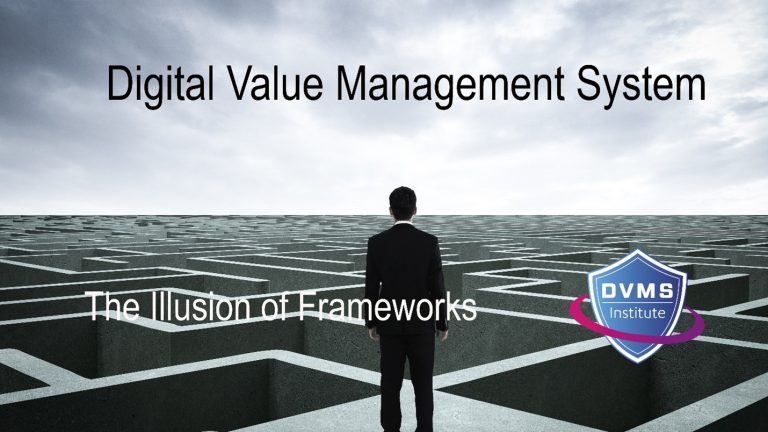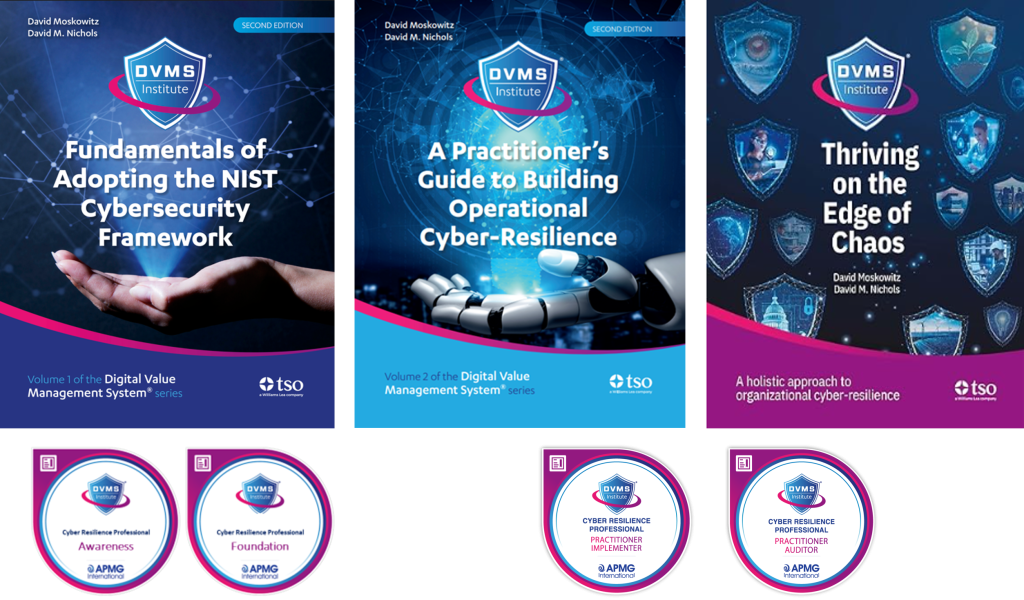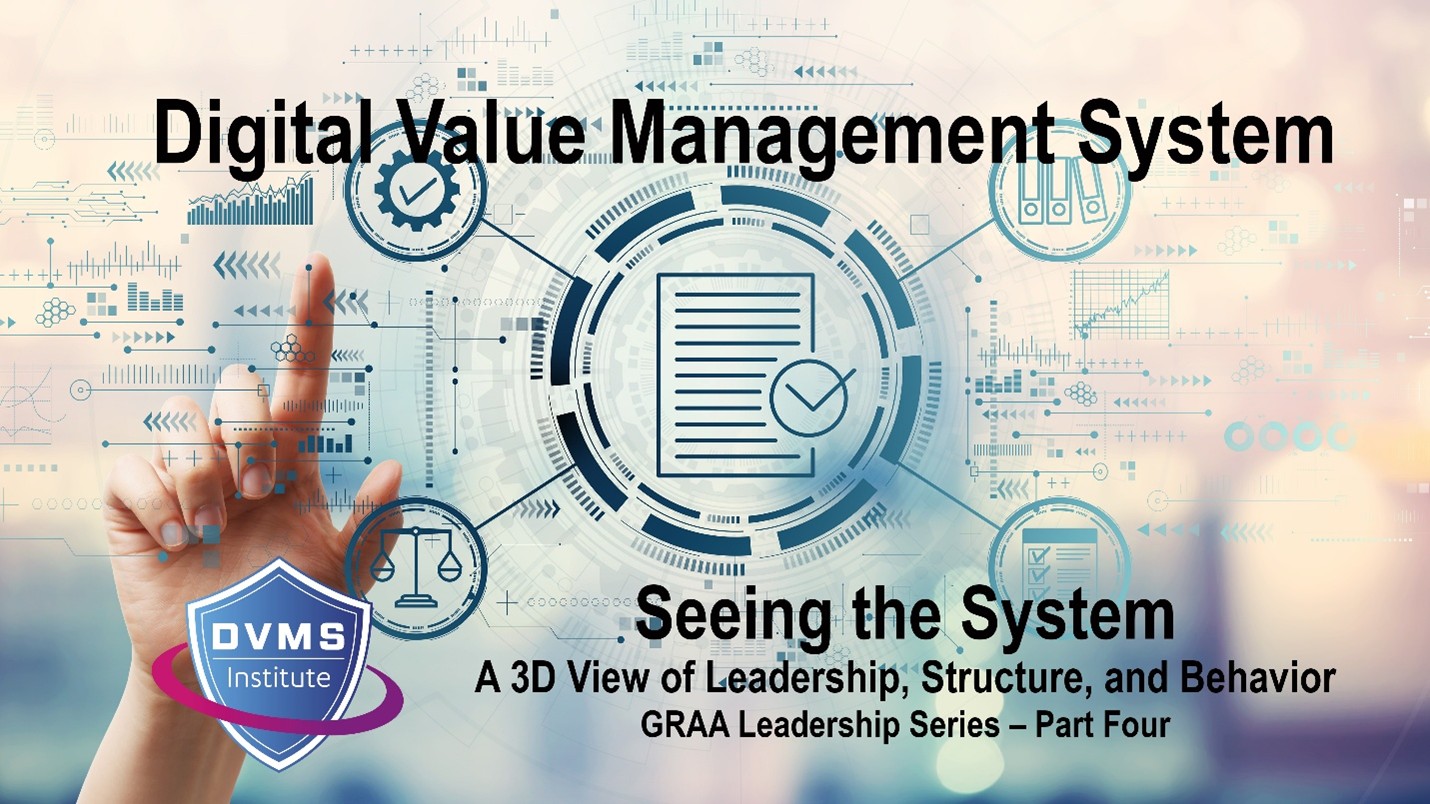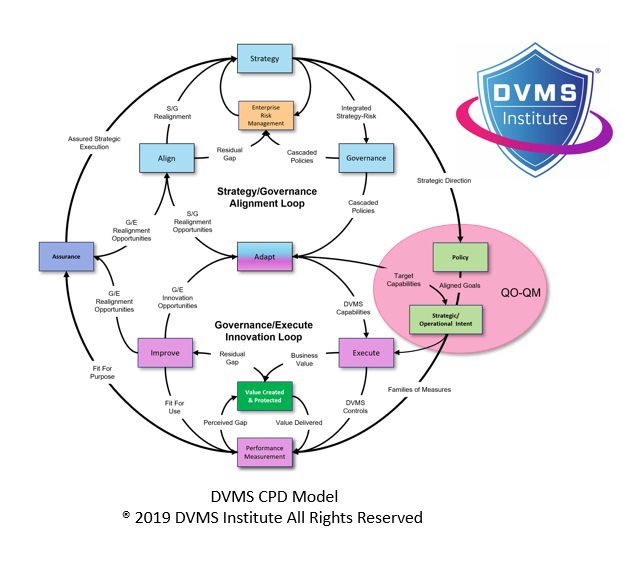The Illusion of Frameworks: Why Checklists Can’t Deliver Confidence – The Assurance Mandate Series – Part 2
David Nichols – Co-Founder and Executive Director of the DVMS Institute
The Comfort of Frameworks
Executives love frameworks because they promise order in a chaotic digital world. ISO 27001, NIST CSF, ITIL, and COBIT all come with explicit language, control categories, and credibility. Adopt the framework, check the boxes, pass the audit — then reassure your board, regulators, and customers that everything is under control.
Except it isn’t.
Frameworks create the illusion of progress, but not the reality of resilience. They measure whether you’ve aligned to someone else’s model of good practice — not whether your organization can withstand disruption, recover quickly, and keep delivering value under pressure.
Frameworks Are Maps, Not the Territory
Every framework is like a map. It shows you the terrain, highlights essential features, and gives you a sense of direction. But a map is not the journey. Owning a map doesn’t mean you’ve actually walked the ground.
The same principle applies to digital governance. Adopting NIST CSF, ISO 27001, or ITIL doesn’t automatically make your organization resilient. It means you’ve put a framework in place that could help you build resilience — but only if you actively incorporate it into a living system.
Too often, organizations wave the map and believe they have finished the journey. Compliance is the map. Assurance is the road beneath your feet.
The Checklist Trap
Frameworks seduce leaders because they provide concrete proof: certifications, maturity scores, and audit reports. These artifacts can be included in board packets, shown to regulators, and displayed to customers.
But here’s the problem:
- A certification tells you that controls exist, not that they work.
- A maturity score tells you how many boxes you’ve checked, not how you’ll perform under stress.
- An audit report tells you how well you matched a template last year, not how ready you are for tomorrow.
This is the checklist trap — mistaking activity for assurance.
Snowflake: Certified, but Not Resilient
Consider Snowflake. In 2024, this cloud data warehousing leader was widely trusted, broadly adopted by enterprises, and integrated into major analytical and data ecosystems. Its compliance posture and reputation indicated maturity, credibility, and alignment with best practices.
And yet, in a major incident, attackers exploited misconfigurations and credential-based access across customer environments. Over 160 customer instances were impacted, including major brands like AT&T, Ticketmaster, and Santander.
Snowflake had the certifications, endorsements, and the trust of many stakeholders. However, when resilience was tested, those credentials proved little protection for affected customers. The compliance and tooling that provided comfort could not replace the adaptive capacity needed during a real attack.
The lesson is clear: certification does not equal resilience. An organization can follow all prescribed standards and still be dangerously vulnerable when disruption occurs.
Why Frameworks Fall Short
The failure is not in the frameworks themselves. ISO, NIST, and ITIL are valuable contributions. The failure lies in how organizations use them: as static end-states instead of dynamic inputs into a system.
Frameworks fall short because:
- They’re retrospective. They measure alignment, not adaptability.
- They’re isolated. Each handles only a part of the challenge (cybersecurity, IT service, governance). True resilience demands integration.
- They’re passive. Frameworks don’t drive behavior; people do. Without a system that embeds culture and accountability, frameworks gather dust.
DVMS: The Operating System for Frameworks
This is where the Digital Value Management System® (DVMS) comes in.
DVMS doesn’t compete with frameworks. It operationalizes them. It leverages the valuable guidance of ISO, NIST, and ITIL, integrating them into a living governance system that continuously connects intent, performance, and assurance.
Think of DVMS as the operating system. Frameworks are the apps. On their own, apps are useful. But without an operating system, they can’t work together. DVMS ensures that they are not just adopted, but also aligned; not just documented, but lived.
The Executive Question
So, the real question for leaders is not: Which framework have we adopted?
It is:
- Can we prove our systems will work under stress?
- Do our frameworks actually improve decision-making and resilience, or just give us certificates?
- Are we managing compliance artifacts — or governing business outcomes?
Closing the Gap
Frameworks provide comfort. Systems provide confidence.
The illusion of frameworks is that they can deliver assurance on their own. The reality is that only a system — one that integrates governance, resilience, and assurance — is the Digital Value Management System (DVMS).
You don’t succeed because you passed the audit. You succeed because when disruption strikes, your organization continues to create, protect, and deliver digital business value.
Frameworks are like applications — useful, but limited in their own right. DVMS is the operating system that runs them, connects them, and ensures they deliver resilience in practice, not just on paper.
That is not the illusion of a map. That is the reality of the journey.
👉 Next in the series: Bridging the Silos — how DVMS connects the languages of governance, cyber, and business.
About the Author

Dave is the Executive Director of the DVMS Institute.
Dave spent his “formative years” on US Navy submarines. There, he learned complex systems, functioning in high-performance teams, and what it takes to be an exceptional leader. He took those skills into civilian life and built a successful career leading high-performance teams in software development and information service delivery.
Digital Value Management System® (DVMS)
The DVMS is an adaptive, culture-enabled overlay system designed to help organizations of any size transition from static, paper-based governance systems to a living, evidence-based system of Governance, Resilience, Assurance, and Accountability (GRAA).
At its core, the DVMS is a simple but powerful integration of:
-
Governance Intent – shared expectations and accountabilities.
-
Operational Capability – how the business actually performs
-
Assurance Evidence – proof that intended outcomes are being achieved
Rather than adding more complexity, a DVMS integrates Fragmented Governance Frameworks and Practices such as NIST CSF, GRC, ITSM, DevOps, and AI into a unified overlay system that enables leaders and regulators to see, in real time, whether the digital business is working as intended—and whether the risks that matter most are being managed proactively.
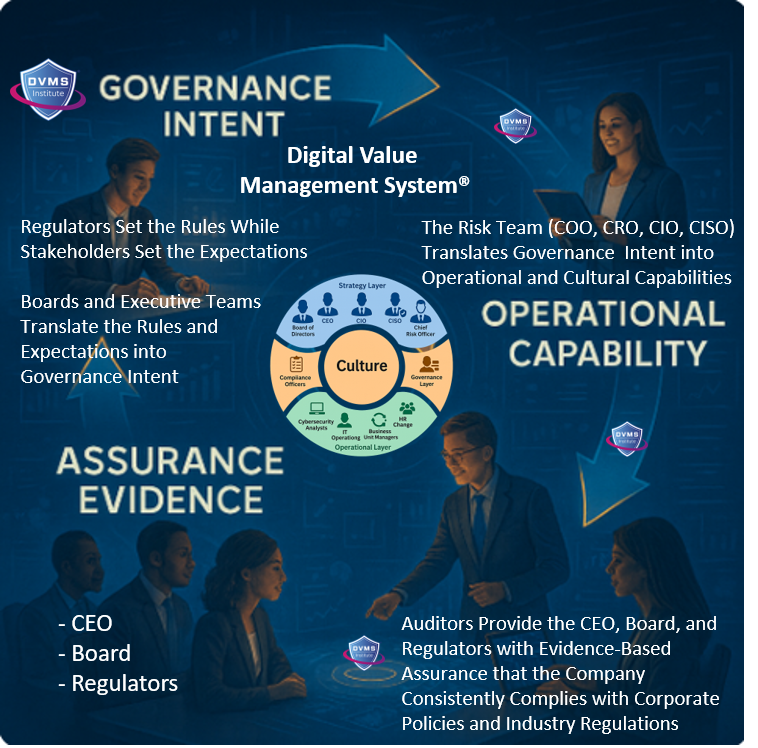
Through its MVC, CPD, 3D Knowledge, and FastTrack Models, a DVMS turns this integration into three distinctive capabilities:
A Governance Overlay that replaces fragmentation with unity. The DVMS provides organizations with a structured way to connect strategy with day-to-day execution. Leaders gain a consistent mechanism to direct, measure, and validate performance—across every system responsible for digital value.
A Behavioral Engine that drives high-trust, high-velocity decision-making. The DVMS embeds decision models and behavioral patterns that help teams think clearly and act confidently, even in uncertain situations. It is engineered to reduce friction, prevent blame-based cultures, and strengthen organizational reliability.
A Learning System that makes culture measurable, adaptable, and scalable. Culture becomes a managed asset—not an abstract concept. The DVMS provides a repeatable way to observe behavior, collect evidence, learn from outcomes, and evolve faster than threats, disruptions, or market shifts.
DVMS Organizational Benefits
Instead of replacing existing operational frameworks, the DVMS elevates them—connecting and contextualizing their data into actionable intelligence that validates performance and exposes the reasons behind unmet outcomes.
By adopting a DVMS, organizations are positioned to:
- Maintain Operational Stability Amidst Constant Digital Disruption
- Deliver Digital Value and Trust Across A Digital Ecosystem
- Satisfy Critical Regulatory and Certification Requirements
- Leverage Cyber Resilience as a Competitive Advantage
DVMS Leadership Benefits
The Digital Value Management System (DVMS) provides leaders with a unified, evidence-based approach to governing and enhancing their digital enterprise, aligning with regulatory requirements and stakeholder expectations.
For the CEO, the DVMS provides a clear line of sight between digital operations, business performance, and strategic outcomes—turning governance and resilience into enablers of growth and innovation rather than cost centers.
For the Board of Directors, the DVMS provides ongoing assurance that the organization’s digital assets, operations, and ecosystem are governed, protected, and resilient—supported by evidence-based reporting that directly links operational integrity to enterprise value and stakeholder trust.
For the CIO, CRO, CISO, and Auditors: an integrated, adaptive, and culture-driven governance and assurance management system that enhances digital business performance, resilience, trust, and accountability
DVMS White Papers
The three whitepapers below present a coherent progression that shifts organizations from compliance-driven thinking to a modern system of Governance, Resilience, Assurance, and Accountability (GRAA). Collectively, the three papers define a comprehensive system for building and governing resilient digital enterprises, grounded in evidence rather than assumptions.
The Assurance Mandate Paper sets the stage by showing why traditional GRC artifacts provide only reassurance—not evidence—and calls boards to demand forward-looking proof that their organizations can continue to create, protect, and deliver value under stress.
The Assurance in Action Paper elevates the conversation from leadership intent to managerial execution, demonstrating how the DVMS operationalizes resilience by translating outcomes into Minimum Viable Capabilities, connecting frameworks through the Create–Protect–Deliver model, and generating measurable assurance evidence that managers can use to demonstrate real performance rather than activity.
The Governing by Assurance Paper elevates the approach to the policy and regulatory level, showing how DVMS functions as a learning overlay system that links governance intent, operational capability, and verifiable evidence into a continuous loop—enabling regulators, agencies, and enterprises to govern by outcomes rather than checklists and to prove capability with measurable, auditable performance data.
DVMS Cyber Resilience Certified Training Programs
DVMS Cyber Resilience Awareness Training
The DVMS Cyber Resilience Awareness course and its accompanying body of knowledge publication educate all employees on the fundamentals of digital business, its associated risks, the NIST Cybersecurity Framework, and their role within a shared model of governance, resilience, assurance, and accountability for creating, protecting, and delivering digital value.
This investment fosters a culture that is prepared to operate within a system capable of transforming systemic cyber risks into operational resilience.
DVMS NISTCSF Foundation Certification Training
The DVMS NISTCSF Foundation certification training course and its accompanying body of knowledge publications provide ITSM, GRC, Cybersecurity, and Business professionals with a detailed understanding of the NIST Cybersecurity Framework and its role in a shared model of governance, resilience, assurance, and accountability for creating, protecting, and delivering digital value.
This investment fosters IT, GRC, Cybersecurity, and Business professionals with the skills to operate within a system capable of transforming systemic cyber risks into operational resilience.
DVMS Cyber Resilience Practitioner Certification Training
The DVMS Practitioner certification training course and its accompanying body of knowledge publications teach ITSM, GRC, Cybersecurity, and Business practitioners how to elevate investments in ITSM, GRC, Cybersecurity, and AI business systems by integrating them into a unified governance, resilience, assurance, and accountability system designed to proactively identify and mitigate the cyber risks that could disrupt operations, erode resilience, or diminish client trust.
This investment fosters IT, GRC, Cybersecurity, and Business practitioners with the skills to assess, design, implement, operationalize, and continually innovate a Digital Value Management System® program that operationalizes a shared model of governance, resilience, assurance, and accountability for creating, protecting, and delivering digital value.
Company Brochures and Presentation
Explainer Videos
- DVMS Architecture Video: David Moskowitz explains the DVMS System
- DVMS Case Study Video: Dr. Joseph Baugh Shares His DVMS Story.
- DVMS Overlay Model – What is an Overlay Model
- DVMS MVC ZX Model – Powers the CPD
- DVMS CPD Model – Powers DVMS Operations
- DVMS 3D Knowledge Model – Powers the DVMS Culture
- DVMS FastTrack Model – Enables A Phased DVMS Adoption
Digital Value Management System® is a registered trademark of the DVMS Institute LLC.
® DVMS Institute 2025 All Rights Reserved

